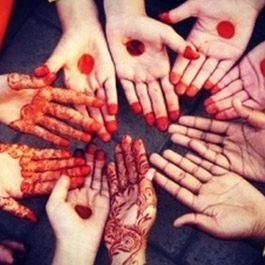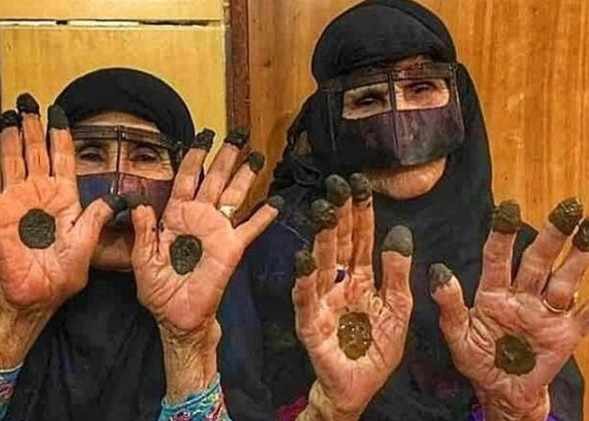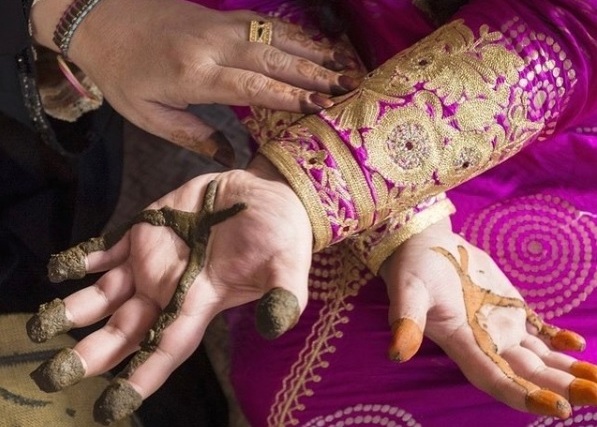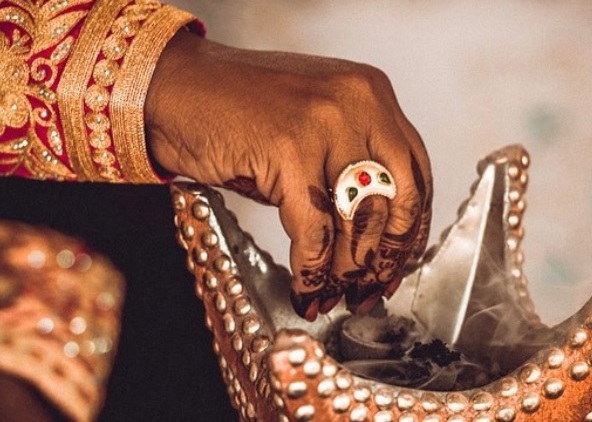




الحِنَّاءة: شَجيرةٌ تشبه شجرة الرُّمان، زهرها أبيضٌ طيّب الرّائحة
الحِنَّاء: حصيلة طحن أوراق الحنّاءة بعد التّيبيس
الحِنَّاء: تستخدم لتزيين الأكفّ والأقدام ولتلوين الشّعور وللعلاج والسحر أيضاً
لم تتغيّر طريقة تحضير (الحِنّاء) أو (الحِنَّة)، والّتي تُدعى كذلك اليَرْنَاء والرَّقان والمُهنّدي، ولا حتّى طريقة زراعة شجيرتها الّتي تنمو في قارّتيّ آسيا وأفريقيا، ولهذا فهي موجودة بكثرة في الصين والهند وباكستان وبلاد فارس واليمن وبلاد المغرب العربي والسودان ومصر، كما وُجدت في بعض بلدان البحر الأبيض المتوسط، واستخدمت لأغراض الزّينة والعلاج والسّحر
اعتادت شعوب هاتين القارّتين على استخدام الحِنّاء في الطقوس المرتبطة بالأفراح والأتراح، حيث يقطفون أوراقها ويجففونها ويطحنوها، ثم يضيفون الماء إلى المسحوق لتكوين عجينةٍ يستخدمونها في صباغة الشّعور وتزيين رؤوس الأصابع وباطن الأكف أو الأقدام، ولم ينحصر هذا التّقليد بالفتيات والنّساء فقط، إنّما عرفه الذّكور من الأطفال والشّبان والرّجال
ويُروى أنّ الفراعنة من أقدم الشّعوب الّذين استخدموا الحِنّاء لتخضيب مومياءاتهم، واستخلصوا من أزهارها العطور. ثمّ دخلت الحِنّاء في الإرث العربيّ والإسلاميّ، وأصبحت من السّنن الّتي يعتقدون بها، فيصبغ بها الرّجال شعورهم ولحاهم، وبها تخضّب النّساء شعورهنّ ويُحْنِّين أصابعهنّ وأكفهنّ وأقدامهنّ، وما إن تُغسل الحِنّاء حتّى يظهر لونها برتقالياً محمرّاً
ومعظم بلدان الخليج العربي والشّام والمغرب خصّصوا ليلة من ليالي العرس لما أطلقوا عليه اسم ليلة الحِنّة الّتي تسبق ليلة الزّفاف، وخلالها تغنّي النّسوة أغانٍ مرتبطة بالحِنَّاء، فيما الثّوب الّذي ترتديه العروس تلك الّليلة يكون أخضر الّلون ويُدعى
ثَوب: (بالعربية، والجمع أَثْوَاب/ثِيْبَان، يرادفها: تُوب). كساء أو لباس. يمكن نطقها ثُوْب: (بالعربية: ثَوب، والجمع أَثْوَاب/ثِيْبَان)، تلفظ أيضاً: ثَوب، تُوب حسب المنطقة، كساء أو لباس. سترة تشبه القميص يرتديه الرجال والنساء في شبه الجزيرة العربية، العراق، بلاد الشام، السواحل الجنوبية والجنوبية الغربية وضفاف الخليج العربي وفي الجزر الإيرانية، وشرق وغرب أفريقيا. قد يشير المصطلح إلى اللباس البدوي النسائي مربع الشكل في منطقة الخليج العربي. تُوب: (بالعربية، والجمع أَثْوَاب/ثِيْبَان، يرادفها: تُوب). كساء أو لباس. يمكن نطقها ثَوب أو ثُوب حسب اللهجة المحلية. سترة تشبه القميص يرتديه الرجال والنساء في شبه الجزيرة العربية، العراق، بلاد الشام، السواحل الجنوبية والجنوبية الغربية وضفاف الخليج العربي وفي الجزر الإيرانية، وشرق وغرب أفريقيا. قد يشير المصطلح إلى اللباس البدوي النسائي مربع الشكل. ثوب
أو توب
حسب اللهجة المحلية. سترة
سِتْرة: ما تُستَر به العورة. والمصدر سِتَار. والسِّتْري والسُّتْرة: رداء قصير يُلبس فوق الثياب، الجمع سَترات وسِتْرات، وبالعامية سُتَر. تشبه القميص يرتديه الرجال والنساء في شبه الجزيرة العربية، العراق، بلاد الشام، السواحل الجنوبية والجنوبية الغربية وضفاف الخليج العربي وفي الجزر الإيرانية، وشرق وغرب أفريقيا. قد يشير المصطلح إلى اللباس البدوي النسائي مربع الشكل.

ففي الخليج تجتمع النّسوة حول العروس، ويغنّين ويضربن على الدّفوف، بينما تقوم (المحنيّة) بنقش الحِنّاء على كفيّ وقدميّ العروس باستخدام عودٍ من النّخل، ثمّ تضع عجينةً في منتصف كفّ العروس أو على رؤوس أصابعها، وهو تقليد اتّبعته المتزوّجات أيضاً
وفي بلاد الشّام تصنع النّساء عجينة الحِنّاء الّتي يضعنها في أطباق كبيرة ويزينّها بالورود، ثم يحملنها على رؤوسهنّ ويرقصن بها في الأعراس الّتي كانت مختلطة حتى وقت قريب. ثمّ تتكفّل سيّدة قديرة أو مجموعة من السّيدات بتحنية أصابع الشبّان والشّابات وأكفّ الأطفال، وفي بعض قرى القلمون السّورية درجت العادة بأنّ الشّخص الّذي يحنّي خنصر العريس أو بنصره بطريقة فنيّة ويلفّها له بمنديل قطنيّ مميّز؛ هو ذاته الّذي يفكّ له المنديل في اليوم التّالي ويحصل على هدية عربون محبّة
أما في تونس فكانت الحنّاء وما تزال طقساً من طقوس الأعراس، حيث يتم تحضير سائل من الحنّاء وبهارات القرنفل وثمار البلوط يُدعى الحَرقوس، وفي قابس توزّع على كل ضيف من ضيوف زفاف العروس عجينة حِنّاء موضوعة في علب صغيرة على الضيوف في يوم الوطيّة
بسويعيه وبوتيله وراضف غشاه عليه
ويه لمع جنديله وطرق الحنا فيديه

The method of preparing henna, also called Al-yarna’a, Al-Raqan, and Al-Mehndi, has not changed, nor has the method of cultivating its shrub. Commonly grown in both Asia and Africa, where it is found in abundance in China, India, Pakistan, Persia, Yemen, the Maghreb, Sudan and Egypt. It is also used in Mediterranean countries, for decoration, treatment and magic.
People from these regions traditionally used
henna in rituals associated with weddings and mourning. The leaves are first
picked and dried, then ground into a fine powder, which is then mixed with
water to form a paste that is used to dye the hair and decorate the fingers and
palms or the feet. This tradition is not only limited to girls and women; as children
and men also practice it.
It is said that the Egyptians are one of the oldest civilizations who used henna, to pigment their mummies, and to extract perfumes from the flowers. Henna then found its way into the Arab and Islamic heritage and became one of the best-preserved customs. Men dye their hair and beards, while women dye their hair, and decorate their fingers, palms, and the soles of their feet. Once the henna has been applied and is washed off, its reddish-orange colour appears.

Most of the countries in the Arabian Gulf,
the Levant and Morocco devoted one of the wedding celebratory nights to what
they called the ‘Henna Night’, normally the night before the actual wedding
ceremony. On this night, the women sing songs related to henna, and the bride
wears a green robe, which is called the ‘Henna Dress’ or Robe.
In the Gulf, women gather around the bride,
singing and beating tambourines, while the Mhaniyya (the woman charged
with applying the henna on the bride) draws elaborate designs with henna on the
palms and feet of the bride using a twig from a palm tree. She uses the paste to
paint the middle of the bride's palms, or the tips of her fingers, a tradition
followed by married women as well.
In the Levant, women make a henna paste which they put in large dishes decorated with flowers and then carry them on their heads and dance with them during weddings that were, until recently, attended by both men and women. A specialised lady or a group of women then paint the fingers of young men and women, and the palms of children. In some of the Syrian villages, a popular tradition is to paint the ring finger, or the pinkie of the groom with an elaborate design, and then wrap a special cotton kerchief around it. The person who does this is the same person who removes and kerchief the next day and will receive a gift as a token of love.
In Tunisia, the henna was and still is part
of the wedding rituals, where a mixture of henna, cloves and oak spices called
al-Harqous, is prepared for this occasion. In Gabis, henna paste is distributed
to each of the bride’s guests in small boxes on the Wattiya day, which is the
day preceding the Henna night.